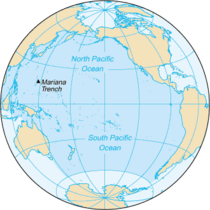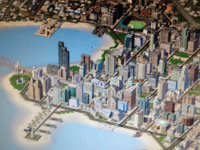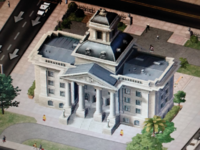Republic of Aurora (2nd)
Republic of the Adriana | |
|---|---|
 Map of the Pacific Ocean | |
| Capital and largest city | Port Elizabeth |
| Official languages | De jure: None; De facto: English |
| Demonym(s) | Adri |
| Government | Unitary parliamentary republic |
• President | Salma Hughes |
• Prime Minister | Joseph Sebastian |
• House Speaker | James Oliver |
• Chief Justice | William Paterson |
| Legislature | National Parliament |
| Independence from the United Kingdom | |
• Recognized | June 30, 1973 |
| Area | |
• Total | 280 sq mi (730 km2) |
| Population | |
• 2021 estimate | 866,081 (159) |
• Density | 3,208/sq mi (1,238.6/km2) |
| Currency | Adri dollar |
| Time zone | Alaska Time Zone |
| Driving side | right |
The Adriana, officially the Republic of the Adriana, is a country located in the North Pacific Ocean. It is located on the southern end of the Adriana Islands. The country shares a land border with the Republic of New Wales (to the north). Adriana's capital and largest city is Port Elizabeth, which is located on the southern side of the Main Island. Other populous communities include Devonport, New Auckland, Port Alivia, and Willingston.
Adriana is a unitary parliamentary republic. The National Parliament Building is located in the capital city of Port Elizabeth. It houses the unicameral legislature. The president is the nation’s head of state. The president is largely a ceremonial figurehead with limited powers. While in office, he or she must remain impartial. The officeholder cannot publicly express any political positions. Most executive power is vested in the prime minister and the Cabinet. The prime minister is the nation’s chief executive and head of government.
The economy of the Adriana is a highly developed social market and market-orientated economy. It is also a high-income economy. The small Pacific nation is a member of the Adriana Islands Union (A.I.U.)—an economic and monetary union comprised of two member states (the Republic of New Wales and the Republic of the Adriana).
The Adriana Islands were first settled by the Spanish in the 1600s. For most of its ruling, the islands remained scarcely populated and underdeveloped. In 1800, the United Kingdom purchased the islands. A wealthy British man named W.J. Kar played a major role in the negotiations. He became the island’s first English governor. Villages grew into cities as thousands of English folk moved to the islands.
By the 1970s, there was political unrest in the Adriana. Citizens of the island’s southern province wanted to break away from the United Kingdom. On June 30, 1973, the southern section of the island chain broke away and became known as the Republic of the Adriana.
History
Spanish and English rule

The islands were first settled by the Spanish in the 1600s. At the time, the Spanish referred to the islands as the Adriana. For most of its ruling, the islands remained scarcely populated and underdeveloped. In the late 1700s, the United Kingdom wanted to purchase the islands for themselves. A wealthy British man named W.J. Kar played a major role in the negotiations. By 1800, the islands were under the sole authority of Great Britain. Kar later became the island’s first English governor. Villages grew into cities as thousands of English folk moved to the islands in search for a better life. The first major English settlement was named New Auckland.
Independence
By the 1970s, there was political unrest in the Adriana. Citizens of the island’s southern province wanted to break away from the United Kingdom. On June 30, 1973, the southern section of the island chain broke away and became known as the Republic of the Adriana. The northern province in the island chain (New Wales) also became independent three years later in 1976.
Immediately after becoming an independent country, a provisional government was established and tasked with writing a constitution. Janet M. Taran served as the chair of the transitional government. The chair remained the de facto head of government and head of state for the Republic of the Adriana until the first national election.
The new government wrote a constitution and presented it to the people in the form of a referendum. On February 5, 1974, a vast majority of the Adriana’s residents voted in favor of the new constitution. It went into effect on February 6. The provisional government was tasked with supervising the first elections, which were scheduled for May 15, 1974. The Liberal Party won most seats in the first parliamentary election, and its leader, Janet M. Taran (the chair of the transitional government), became the nation’s first prime minister (head of government). Parliament elected Clark Patterson as the Adriana’s first president (head of state).
The Republic of the Adriana joined the Adriana Islands Union (A.I.U.)—an economic and monetary union—in 1978.
Contemporary history
Janet M. Taran remained prime minister until 1986. The following prime ministers were Jon Johnson (1986—1998), Daniel Cooper (1998—2002), and Louis Roberts (2002—2010). The country suffered from the Great Recession in the late 2000s. This resulted in the landslide election victory for the Conservative Party in 2010. Prime Minister Joe Sebastian went on to lead his Conservative Party to two more victories in 2014 and 2018. However, the Liberals made gains with each election.
Geography
| Region | Area |
|---|---|
| Main Island and Northern Tier | 270 sq mi |
| Eastern Island | 10 sq mi |
| Total | 280 sq mi |

The Adriana Islands are located approximately midway between the continental United States and the Hawaiian Islands. The Republic of the Adriana is located on the southern end of the island chain, while the Republic of New Wales is located on the northern half. Both the Republic of the Adriana and the Republic of New Wales share a land border on the southern end of the centermost islands. Republic of the Adriana is made up of mostly low-rolling hills and some mountains.
Regions
Northern Tier
The Northern Tier is the northernmost section of the country. It shares a land border with New Wales (to the north). This is the country's only land border. The Northern Tier can be divided into three subregions: The Northeast Tier, the North Central Tier, and the Northwest Tier. These three areas are divided by waterways which exit New Wales from the north. The Northeast Tier consists of mountains, hills, forests, farms, suburbs, and some small cities. Some of its major settlements include Calgary, Murdoch Beach, and Palmerston. The North Central Tier consists of hills, forests, farms, towns, and cities. Its largest settlement is the City of Devonport. Other populous communities include Aleeda, New Castle, and Victoriaville.
Main Island
The Main Island is located south of the Northern Tier. The two are separated by a waterway. They are connected by a series of bridges. Most of the island is green—consisting of forests and farmland. The island's topography is hilly, with a small cluster of mountains located near the center. Roughly 400,000 people live in the southeastern corner of the island. It is known as the Port Elizabeth-Windsor Corridor. This urban area includes the cities of New Auckland, Port Elizabeth (the nation's capital), Elizabethtown, Willingston, and Queenstown. It is located between the Pacific coastline and the Back Bay.
Other populous communities on the Main Island include Baylee, Catalina, Port Alivia, and West Catalina. Smaller islands surround the Main Island; only two are inhabited—Louistown Island and Kingstown Island.
Eastern Island
Eastern Island is a small island east of the Main Island. It is uninhabited.
Transportation

Rail
Railroads link Adriana's Main Island and Northern Tier with the Republic of New Wales. They are primarily used for transporting freight and passengers. The largest train stations are situated in the counties of Port Elizabeth and Port Alivia.
Highways
There are several major highways in the Adriana. They are part of the Transcounty Highway System.
- T-1: Runs from the New Wales border through Victoriaville, Port Alivia, and Port Elizabeth
- T-2: Runs from Baylee (Saxons County) through Victoria Beach, Port Elizabeth, Queenstown, and Willingston
- T-3: Runs from the New Wales border though the counties of West Cambria, West Kingsland, and Port Alivia
- T-4: Runs from Port Alivia through North Leona County
- T-5: Runs from the New Wales border though the counties of West Upland, East Kingsland, Central Kingsland, and West Kingsland
Major airports
- Port Alivia International Airport — Port Alivia County
- Port Elizabeth International Airport — Elizabethtown, Port Elizabeth County
Major seaports
Seaports are located in the following counties: Central Kingsland, North Leona, Port Alivia, Port Elizabeth, Saxons, South Devon, and Windsor.
Demographics
Population by region
| Region | Population |
|---|---|
| Main Island and Northern Tier | 866,081 |
| Eastern Island | 0 |
| Total | 866,081 |
*Last updated on December 21, 2020
Most populous counties
| Rank | County | Region | Population |
|---|---|---|---|
| 1 | Port Elizabeth | Main Island | 274,042 |
| 2 | Port Alivia | Main Island and Northern Tier | 144,169 |
| 3 | Windsor | Main Island | 124,594 |
| 4 | South Devon | Main Island and Northern Tier | 62,769 |
| 5 | Saxons | Main Island | 43,168 |
| 6 | East Kingsland | Main Island and Northern Tier | 37,430 |
| 7 | South Victoria | Main Island | 28,259 |
| 8 | Central Kingsland | Main Island and Northern Tier | 21,821 |
| 9 | Calgary | Northern Tier | 20,909 |
| 10 | North Murdoch | Northern Tier | 19,089 |
*Last updated on December 21, 2020
 |
 |
 |
Government and politics
President since 2009
Prime Minister since 2010

Head of state
The president is the nation’s head of state. The president is largely a ceremonial figurehead with limited powers. While in office, he or she must remain impartial. The officeholder cannot publicly express any political positions. The parliament elects the president to a five-year term. The position is not term limited. The current president is Salma Hughes.
| # | President | Tenure |
|---|---|---|
| 1 | Clark Patterson | 1974—1994 |
| 2 | John Hunter | 1994—2009 |
| 3 | Salma Hughes | 2009—present |
Head of government
The prime minister is the nation's head of government and chief executive. Most executive power is vested in the prime minister and the Cabinet. The current prime minister is Joseph C. Sebastian.
| # | Prime Minister | Party | Tenure |
|---|---|---|---|
| 1 | Janet M. Taran | Liberal | 1974—1986 |
| 2 | Jon Johnson | Conservative | 1986—1998 |
| 3 | Daniel Cooper | Conservative | 1998—2002 |
| 4 | Louis Roberts | Liberal | 2002—2010 |
| 5 | Joseph C. Sebastian | Conservative | 2010—present |
Legislature
The National Parliament is the country's unicameral legislature. It consists of 51 Members of Parliament (MPs) representing 17 electoral districts; there are three members per district. The National Parliament Building is in the capital city of Port Elizabeth. The country's two major political parties are the Liberals and the Conservatives. The first parliamentary elections were held in 1974. Elections are held every four years. The current Speaker of the Parliament is James Oliver.
The Conservative Party has been in power since 2010. Its leader, and the current prime minister, is Joe Sebastian. The current opposition leader (leader of the Liberal Party) is Susan G. Ellis. She assumed the role of leader after her party’s 2018 election loss. Angelina J. Voight was the opposition leader before Ellis. Voight led the Liberal Party in two failed elections—2014 and 2018.
Legal system
The Adriana has a three-tier court system. At the lowest level are magistrate courts, situated in most cities and large towns across the country. Above them are two district courts, serving as both appellate courts and courts of first instance; they are situated in Port Alivia (serving the country’s northern district court) and Port Elizabeth (serving the nation’s southern district court). The third and highest tier is the National Court (or Supreme Court), located in Port Elizabeth; it serves a dual role as the highest court of appeals and the High Court of Justice. In the latter role, the National Court rules as a court of first instance, allowing individuals to petition against the decisions of state authorities.
There are eleven National Court Justices. William Paterson is the current Chief Justice of the National Court.
Levels of government
Military

The Adriana Islands Military Alliance (A.I.M.A.) is a military alliance between the Republic of the Adriana and the Republic of New Wales. A.I.M.A. constitutes a system of collective defense. In other words, its independent member states agree to mutual defense in response to an attack by any external party. Their headquarters is located in the City of Port Elizabeth.
The Military of the Republic of the Adriana consists of three branches: army, air force, and navy.
Army
- Fort Alivia — Fort Alivia Village, Port Alivia County
- Fort Saxons — Aberdeen, Saxons County
- Fort Windsor — Queenstown, Windsor County
Air force
- Fort Saxons Air Force Base — Aberdeen, Saxons County
- Fort Windsor Air Force Base — Queenstown, Windsor County
Adriana's navy consists of a small fleet of patrol boats. These relatively small naval vessels are designed for coastal defense, border protection, immigration law-enforcement, and search and rescue operations.
Economy

The economy of the Adriana is a highly developed social market and market-orientated economy. It is also a high-income economy. Adriana’s economy involves agriculture, tourism, manufacturing, and a thriving commercial sector. High tech industry has boomed in recent years—especially around the cities of Port Elizabeth and Port Alivia. Adriana's development of cutting-edge technologies in software, communications, and the life sciences have evoked comparisons with Silicon Valley (in the United States). Some have nicknamed the Republic of the Adriana the “Silicon Valley of the Pacific.”
The small Pacific nation is a member of the Adriana Islands Union (A.I.U.)—an economic and monetary union comprised of two member states (the Republic of New Wales and the Republic of the Adriana). As a result of being part of an economic union, there is freedom of movement of goods and services between Adriana and New Wales. In other words, there is no “hard border” between the two countries. Because the Adriana Islands Union is also a monetary union, both New Wales and Adriana share the same currency—the Adri dollar.
Culture
Important dates
- February 6 — Constitution Day
- May 15 — Election Day
- June 1 — Swearing in of new parliament (Note: It was July 1 before 2022)
- June 30 — Independence Day


